How to Do Capability Mapping Like a Pro
Reading Time:

Lead the pack with the latest in strategic L&D every month— straight to your inbox.
SubscribeCapability mapping is an effective way to understand the current state of your organisation, what capabilities you have and those you’re missing, and what gaps are stopping you from getting where you want to go.
Think of it as an all-in-one tool for business success, workforce planning, organisational development and operations management. It’s really that handy—if you know exactly what you’re doing, that is.
In this guide, we’ll walk you through how to break down and map your capabilities (and exactly why you should), plus how to create an implementation plan for successful capability mapping in your organisation.
What is a capability map?
A capability map looks at what an organisation does and can do in terms of expertise, knowledge, behaviours and processes. It’s a visual outline of the current capabilities an organisation possesses and the capabilities that should be prioritised in order to reach a desired future state.
What does a capability map look like?
Let’s have a quick reminder of what a capability is.
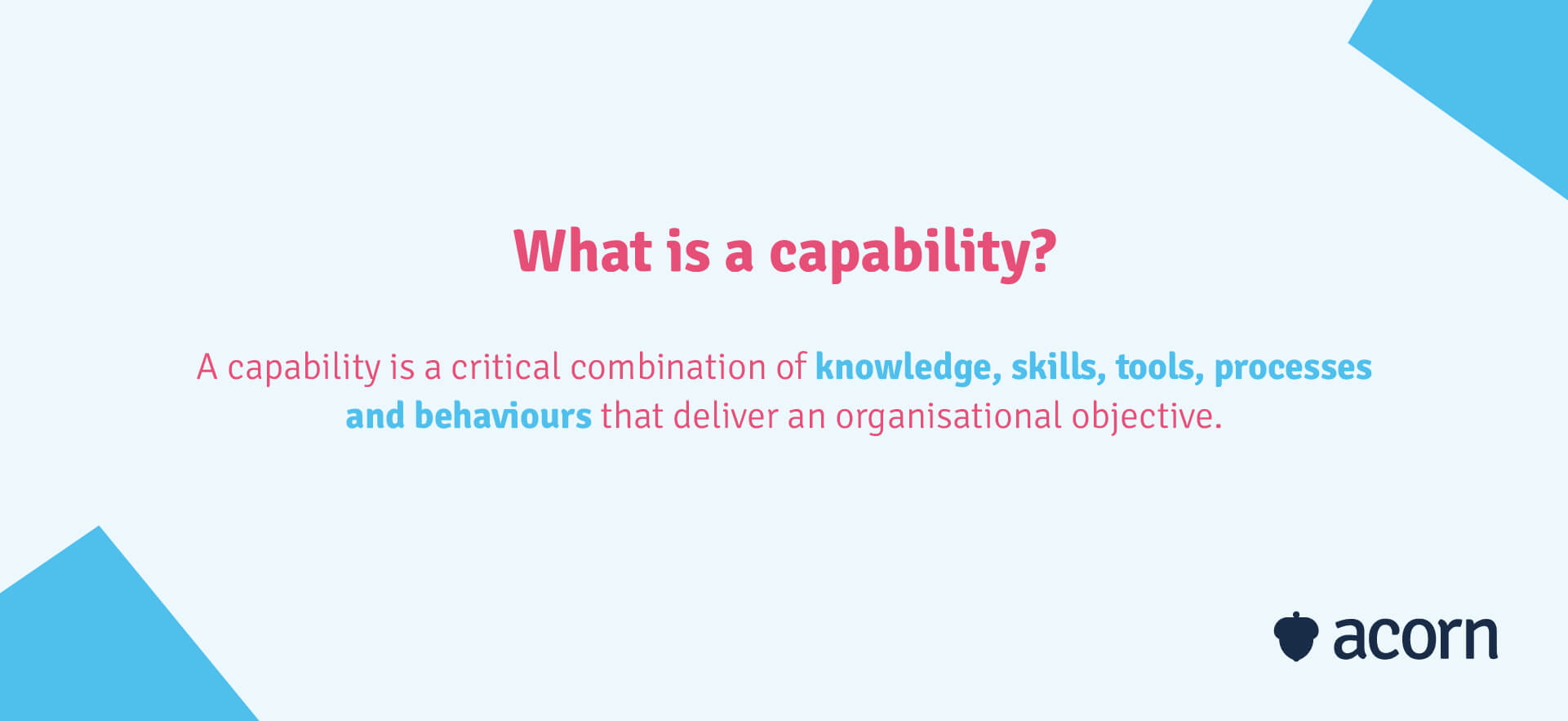
Capabilities have some defining qualities, too:
- They describe what, not how your business works.
- They have or define an outcome.
- They are unique, e. not applicable to different functions of business or capability sets.
- They can be tangible, e.g. Product Manufacturing or (at face value) intangible, like Adaptability.
So, a business capability map visually depicts your capabilities in a particular state, whether that’s what you’re currently doing to reach strategic goals or the maturity level required of a certain capability to reach your desired future state. The idea is to quite literally map your business capabilities against your strategic outcomes, so you know where your current strengths and weaknesses are and what you need to focus on to get to where you want to be.
It differs from a capability framework (which outlines an exhaustive list of necessary skills, knowledge and behaviours) in that a capability map focuses on visualising capabilities by expertise, business value or function. But like capability frameworks, business capability maps are usually arranged hierarchically to display their granularity.
Understanding the granularity of capabilities helps you better design learning experiences. Most learning solutions focus on skills, which expire at a rate of less than five years. That’s part of the reason we pioneered the performance learning management system (PLMS). It allows you to match capabilities to relevant content, and measure learning outcomes by tangible performance improvements. That shows direct causation between learning and organisational performance, only giving you more data with which to determine strengths and weaknesses.
At the highest level, there are a few capabilities that are core to business success, each being followed by a set of complementary capabilities that support them.
Level 1: Organise the map
At your first and highest level of decomposition, you are creating a logical way to flesh out and organise your lower levels. It’s common to define business capabilities based on value streams/chains or key functions that take you from conception to market.
The best way to approach this is to define the key elements of your value chain (because this can include business functions). It has the added value of resonating with your senior executives, which aids in building consensus at an early stage.
Remember: Business functions describe how work gets done, whereas business capabilities focus on enabling the outcome of that work for strategic purposes. A capability also only appears once in a map; sub-functions can occur multiple times in, say, an org chart. Here’s a look at a potential first level of business capabilities.
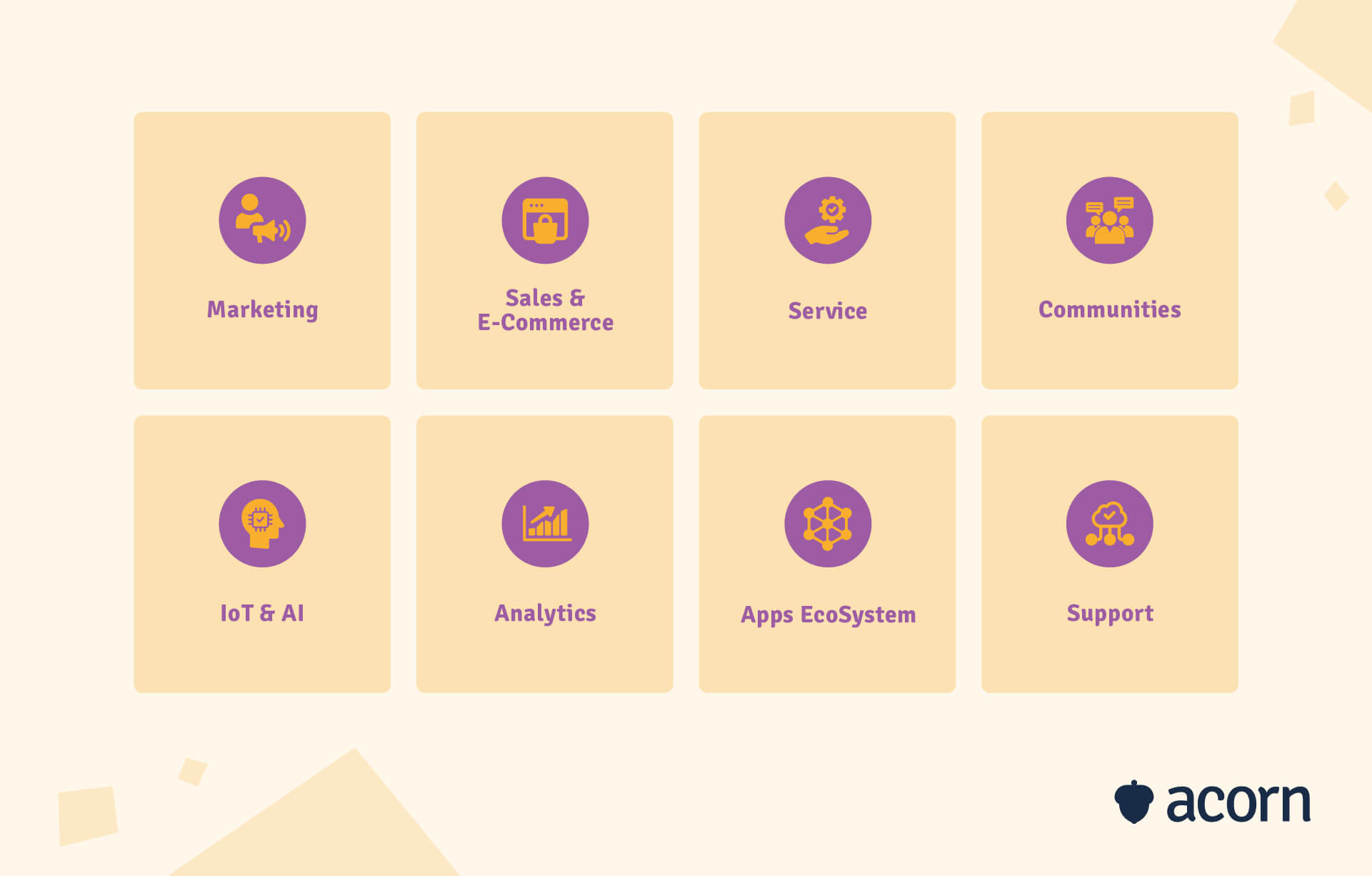
Some organisations use this first level solely to categorise capabilities, so that Level 1 labels business capabilities rather representing them.
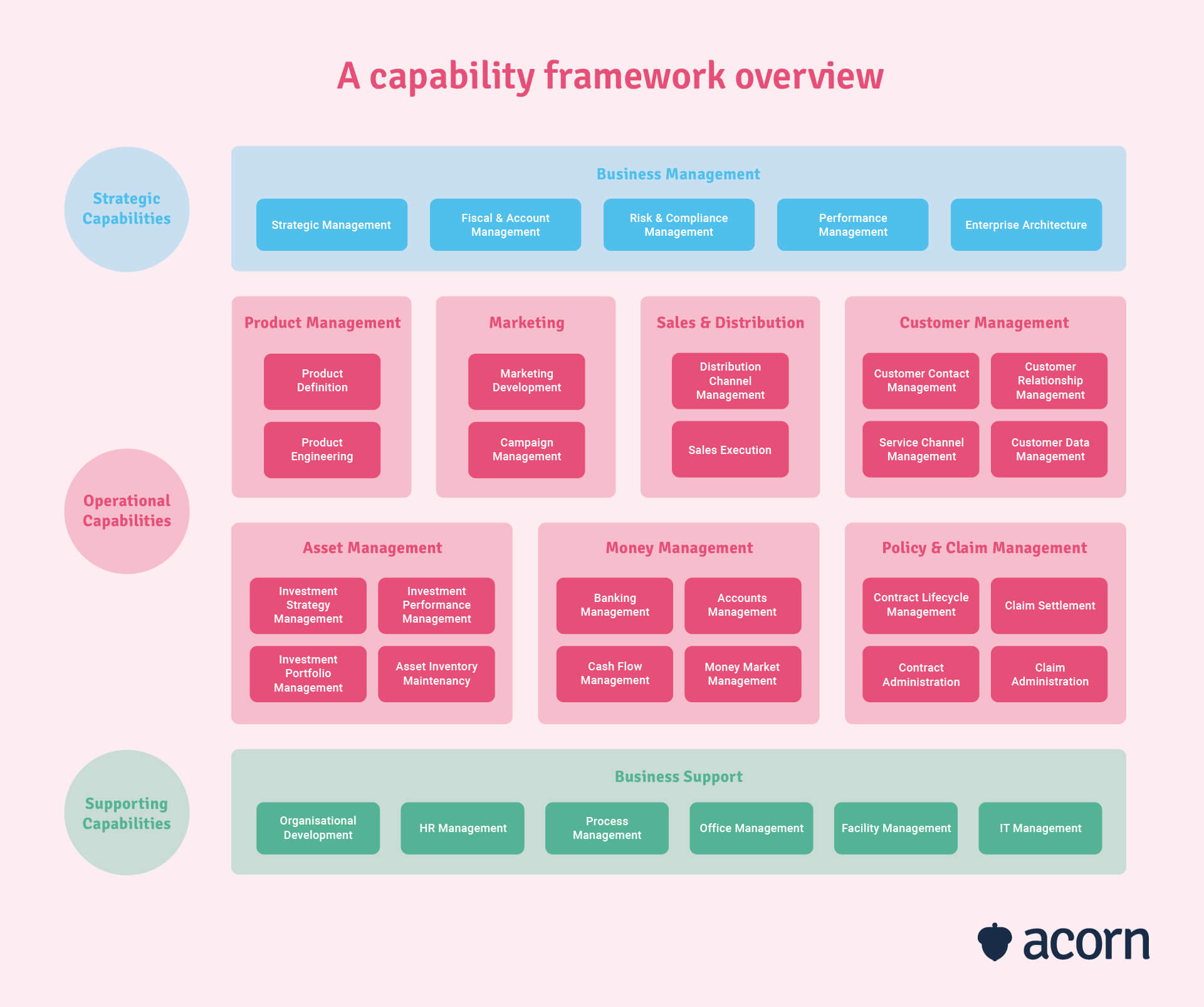
You can see there are three core groupings of business capabilities in this example: Strategic, operational and business support. In this case, the categories can be used to determine resourcing for capabilities at lower levels.
- Strategic capabilities are important for your long-term future. These may even have a separate budget as a way of avoiding innovation squeeze.
- Operational or customer-facing capabilities are core and seldom outsourced. They may chew up the majority of your resources and/or budget. These are your differentiating capabilities.
- Supporting capabilities may be outsourced to partners or third parties. The reason for this is many external choices have these supporting capabilities as their differentiating capabilities. For example, Business Consultants, who fall under Process Management, are often external and brought in to, well, consult.
There’s no “ideal” number of core capabilities at this level. You may have five or ten. Just remember that you will be breaking these down further—so while you want unique, un-replicable capabilities, you also don’t want something that is incredibly complicated to understand. This is supposed to be an easy-to-read visual aide, after all.
Level 2: Develop the map
Here, we start to get into the weeds. This level gives you the necessary detail to make more informed strategic and resourcing decisions.
A key point is that you don’t need the same number of sub-capabilities for every core capability. A tech company may have ten capabilities under Product Management, but only three under Marketing. This comes down to the drivers defined as critical to your business.
The total number of capabilities you have at this level will ultimately depend on the complexity of your organisation and the reason you are creating a business capability map. However, we have found that at a maximum you could have over 100 capabilities, at which point it becomes too complex to have effective strategic discussions.
As with all capabilities, you want to define your sub-capabilities as a what or intended outcome, not a how. “Writing content”, as an example, is a process. “Content creation” is both the what and intended outcome.
Many organisations leave it at this level, but to get ahead of the competition you can go deeper.
Level 3: Gain more insight
In most cases, two to three levels of sub-capabilities are enough. However, some organisations go deeper. A third level of sub-capabilities can help provide more insight into your second-level ones.
This granularity further ensures the right capabilities are represented at that second level. You could find that while originally a Level 3 capability, Customer Management should actually be at Level 2 under Sales.
If we follow our previous example, this decomposition could look like:
- Marketing
- Lead Generation
- Content Creation
Or:
- HR Management
- Recruitment
- Candidate Evaluation.
Level 4: Further refinement
For smaller companies or those approaching capability mapping for the first time, this level of granularity is usually not needed. It’s more common in mature organisations who may use a capability map from an operational viewpoint, so that their enterprise business capabilities provide a link to processes and technology.
Take the following example. Levels 4 and 5 look at processes like opportunity mapping and revenue assessment that support the capability of Client Segmentation. While this technically goes against what we’ve said about not translating processes into business capabilities, it allows you to break down your business in way that connects the high-level views at Levels 1 and 2 with the specific activities needed to support them.
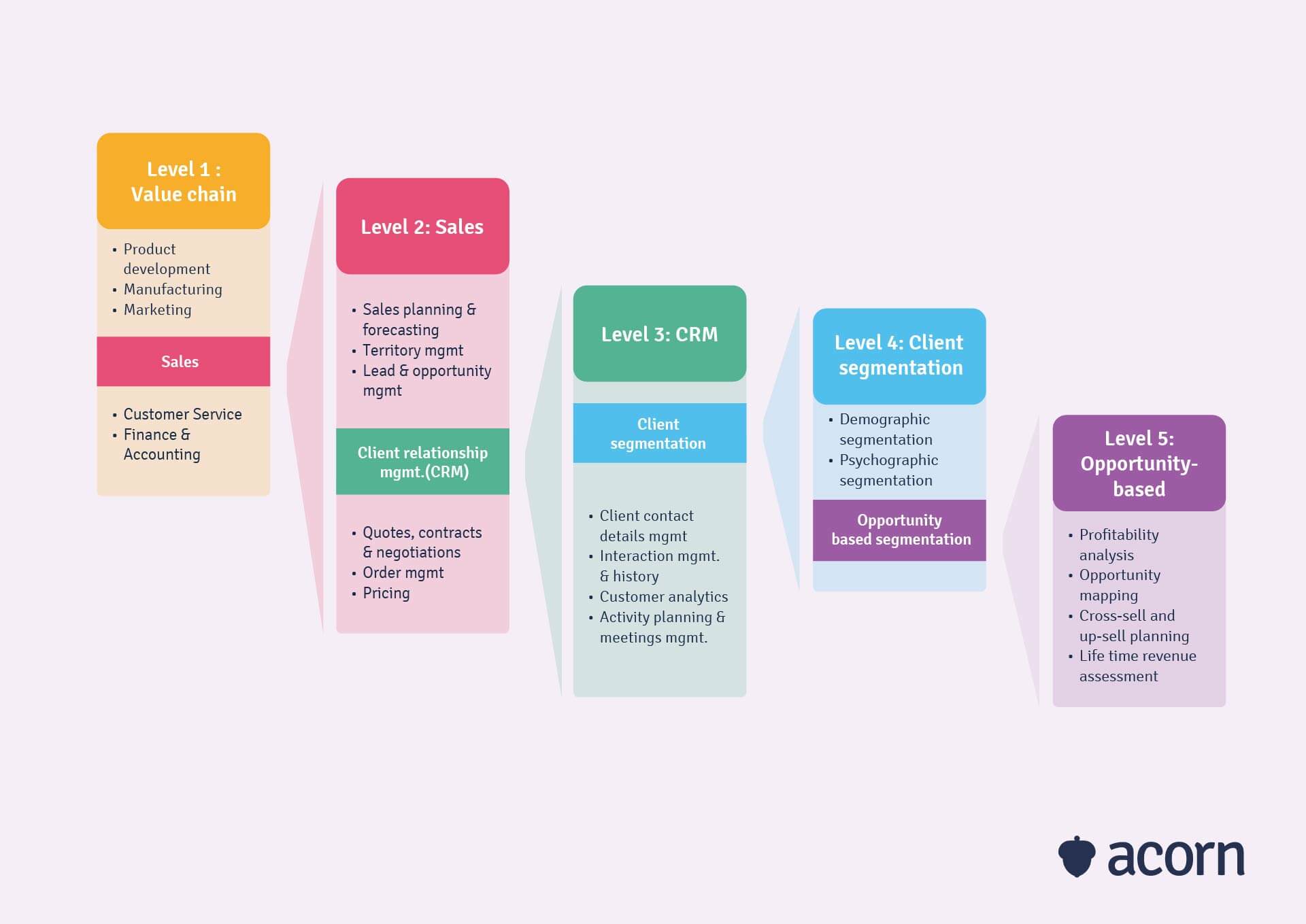
Why do I need a visual capability map?
While you’ll likely be familiar with flowcharts, diagrams, org charts, timelines and the like, a capability map is a more helpful bird’s eye view of how your business works. This means you can:
- See more clearly what’s more working
- Understand where improvements need to be made
- Create a shared language of business.
A map is easily read and understood, keeps the focus on your big picture and aligns your internal business processes with people and technology. It’s like a companion for all your other planning, strategy and business documents and allows you to more accurately undertake gap analysis. And this is so because capabilities don’t stand alone. They are contextualised by your strategic business outcomes.
For that reason, there two key benefits to be gained from capability mapping:
- Better prioritisation of resources
- Smarter investment decisions.
Prioritisation: Heatmapping
In many cases, your business capability map will show your current state. The advantage of mapping business capabilities is that the things you do today are things you should be able to do in future. This makes mapping for your future state somewhat easier, especially if you have a tool to articulate the changes required to get you to your future state. Enter: The heatmap.
A heatmap visually determines what capability is the highest priority in terms of achieving desired change. It’s the result of juxtaposing existing capabilities with various parameters, with the outcome showing a necessary level of change or action. (So, one could say that heatmapping shows what’s hot and what’s not.)
It’s common for blue or green to represent no change or action required, while yellow, orange and red show ascending levels of urgency.
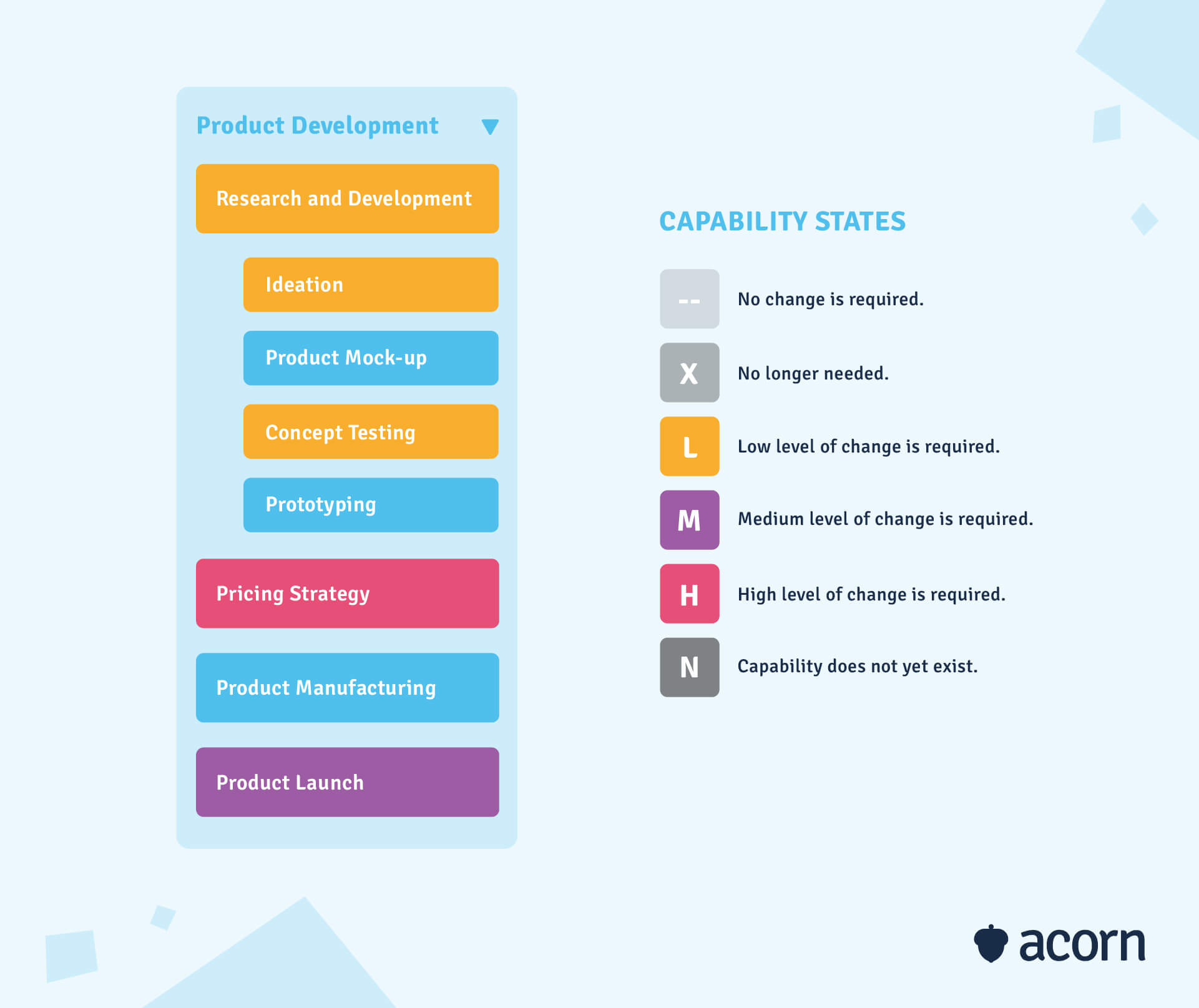
Understanding what business capabilities need attention is important to realising the true impact of your map. It may be tempting to focus on Product, because that’s going well. But you could inadvertently neglect Professional Development for your employees while focusing all your energy on developing great products. Yet without PD, your employees will start to lack the capabilities necessary to innovate.
Among other things, many organisations will use a heatmap to prioritise business capabilities by:
- Maturity (i.e. how optimally developed or utilised it is in your organisation)
- Adequacy of resources available for a certain capability
- Business value, strategic importance and/or contribution to competitive positioning.
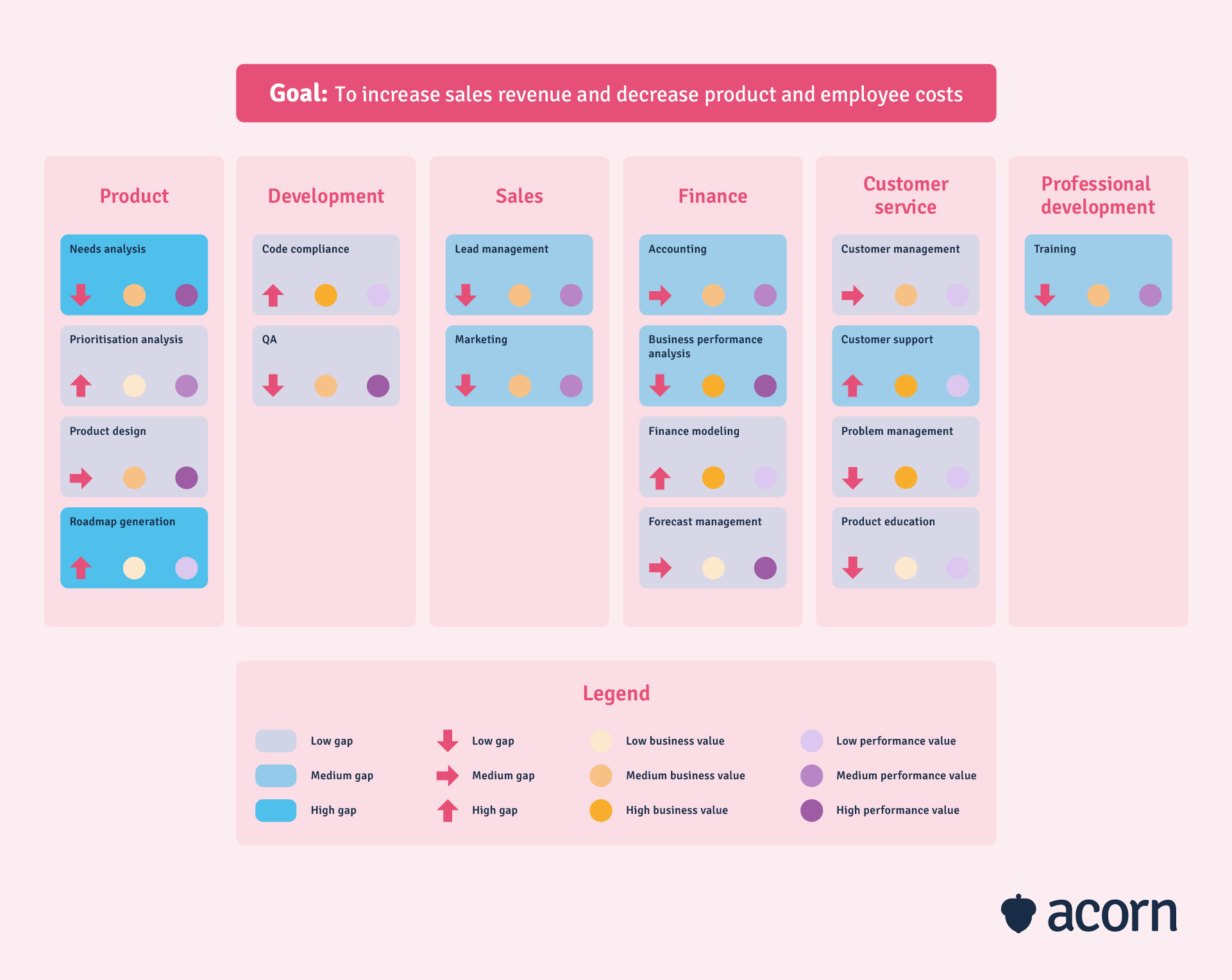
You’re not limited in the rationale for heatmapping, though. The above example shows sub-capabilities scored four different ways. This can give further nuance to each, as well as more insight into prioritisation. Some rationales for heatmapping include:
- Realisation of the capability
- Risk of extinction
- Value to business
- Strategic performance.
Why heatmap on top of your capability map?
Every business function in your company will likely have at least one major project they are working on independent of other departments. Senior executives may know that each project is valuable for its unique outcomes (at enterprise, operational and departmental levels), but are they equally valuable? Likely not, unfortunately. Without seeing and understanding the big picture, you can’t be sure your resources are being effectively allocated.
Another reason the heatmap is useful is that it is fit for purpose. When we factor in target states of capabilities, it shows who will be impacted by change and when that impact will likely be felt. If Lead Generation in Marketing shows orange against a rationale of risk of extinction, then it’s probably going to require more immediate attention than a green Needs Analysis in Product Development—because if you’re not finding customers, how can you be sure what they need?
Essentially, a heatmap enables to you stay ahead of change and ensures that your capability map remains stable.
Investments: Overlay business & technical architecture
All companies, regardless of size, will have to make investment decisions based on their unique alignment of business, people and technology. Aside from business leaders, business and technology teams stand to benefit the most.
For your technology arm, a business capability map is a way to shape their IT architecture and rationalise their choices. For HR and business architects, it empowers strategic decision making and visibility into the process. For executives, it shows the return on investment of technology used by employees.
Strategic planning
When planning for long-term, multi-year investments, a capability map (plus heatmapping) can show the gaps between your current state and your future goals so you can better identify those areas that need finances.
Roadmap
Part of conceptualising new products or services is a) determining required resources and b) ensuring it aligns with the company mission. A capability gives you the high-level perspective for this, providing a pathway that keeps everyone on the same track while showing the prioritised investment needs of other business capabilities.
Consolidations
In the event of a merger, acquisition, CEO turnover or end of contract, technology and core functions can be re-examined to determine redundancies or inefficiencies.
Rationalisation
You need to innovate quickly to stay competitive, but you also have to justify decisions to executives to do so (especially when introducing new technology that comes with a hefty price tag). A capability map helps align technology with business strategy by structuring the pathway for business transformation.
At-risk capabilities provide opportunities, while redundant capabilities offer room for efficiency. A map also reduces information siloes and can potentially accelerate time-to-market on projects with shared visibility and understanding.
Risk management
Understanding what (processes, roles, outcomes) is dependent on technology means you can better identify outdated or at-risk elements in your business. You’re then also able to visualise any potential but unintended consequences that could result from a change in your tech landscape—for example, job role redundancies. This way, you’re validating initiatives before they begin.
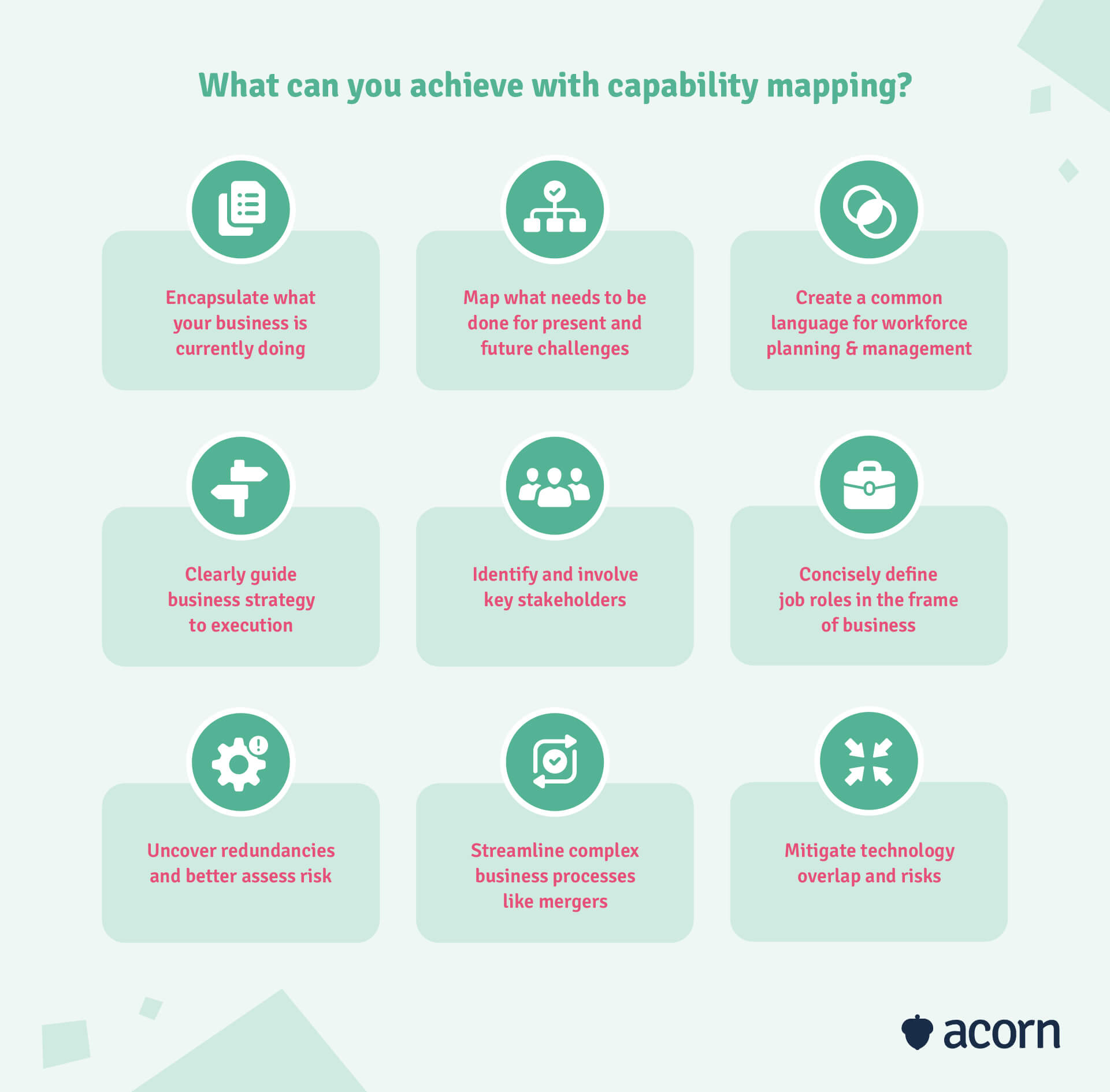
A guide for implementing a capability map
There are scenarios where capability mapping begins with the sponsorship of top-level executives, but it most commonly finds its grassroots in HR. This means implementing a business capability map is as much about creating one as it is generating buy-in for the process. The process to do so follows:
- Build a case for consensus
- Generate buy-in
- Establish ownership.
Build the case for capability mapping
Imagine a scenario in which your organisation embarks on a multi-year change project as directed by C-Suite. This may involve purchasing and adapting an existing reference business capability model, engaging high-priced consultants, or both, but neither option comes with true internal support or contribution. The result is a generic business map that doesn’t truly capture the essence of your company. It’s then underused and forgotten.
Much like building consensus for other business-related implementations, business capability mapping won’t stick if there isn’t a solid reason for using it. You want to find a common thread or gap in your current business architecture management that affects all and justifies the introduction of a new process. The need for a capability map could otherwise be contested if your organisation has successfully plotted along without one for years.
A solid case for capability mapping should articulate:
- Any relevant challenges and opportunities that exist within your organisation and why they exist. This is important for laying the groundwork for the importance of a capability map.
- The impact of not addressing them on your future state. Quantify this where possible, such as in employee attrition, growth or ROI.
- A value proposition of expected benefits, results and points of impact.
Where a capability map gives you the what, executives and stakeholders will want awhy. The following points and table demonstrate some common benefits you can translate to your unique business needs.
- Identify duplication of effort and opportunities for simplification
- Decrease time-to-market for products and strategies
- Build traceability between strategic objectives, execution and tracking metrics
- Rationalise business-critical decisions
- Create an inherently common language and mental model of business
- Save time on impact and state analysis
- Discover which value streams are necessary for a new product or service.
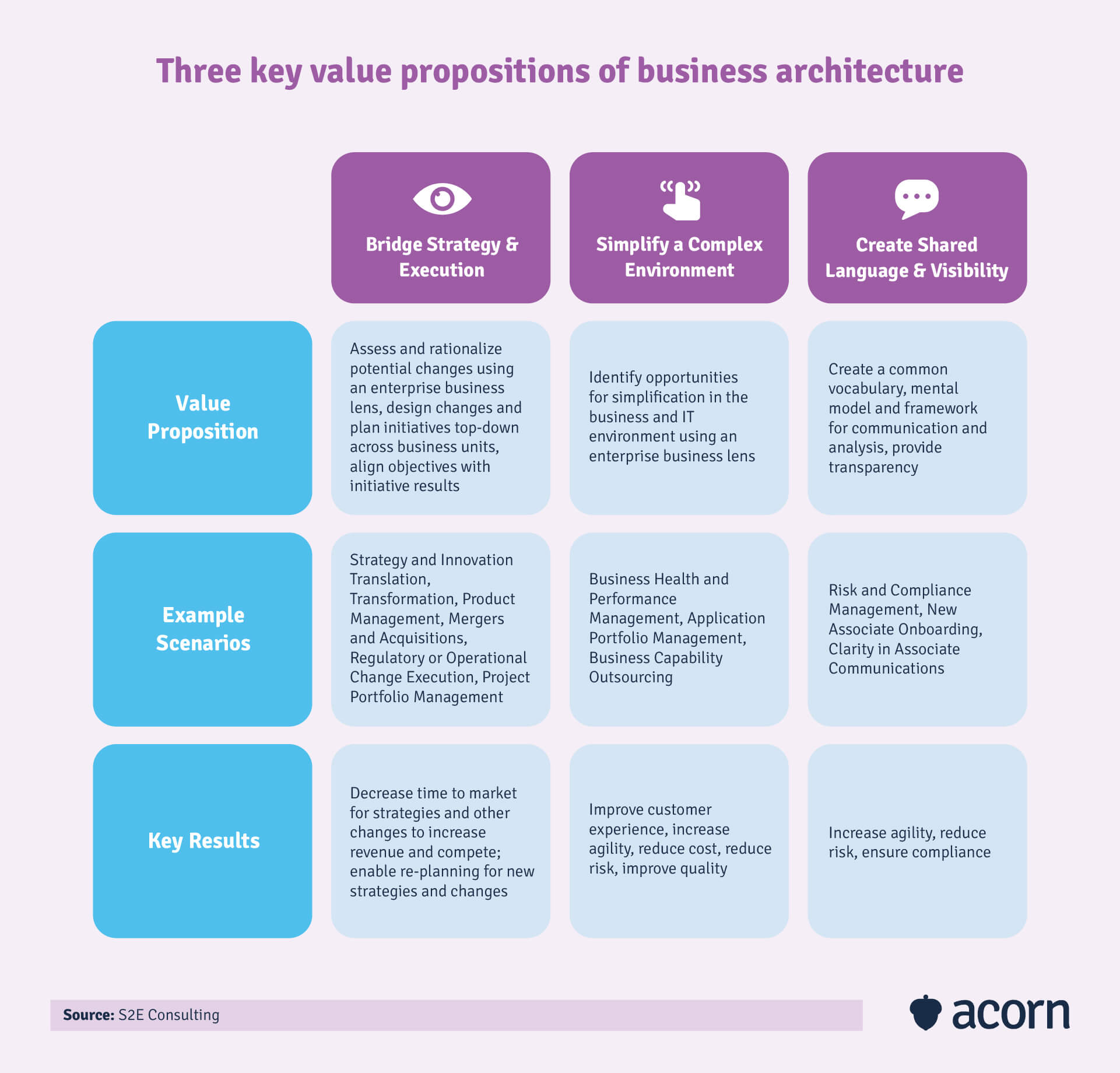
Generate management buy-in
One of the main challenges of business capability mapping is adopting a culture of usage and support for the process. This comes back to lack of communication surrounding the desired outcomes and/or value add. Without buy-in, it then becomes just another HR or IT endeavour.
Buy-in, which stems from your business case, needs to be based upon capability mapping being a pain killer, not just a nice-to-have supplement. If you don’t have the foundational belief that it’s an underlying component of strategy and operations, you won’t get support for it.
There should be more than one champion in your organisation for a capability map at multiple levels of your organisation. Technology and business executives are the highest roles to aim for, as they set the tone for your managers.
Strategies to highlight the wins management stand to gain as champions
- Start small and illustrate with a team-based capability map rather than organisation-wide. This also allows for iteration and refinement on a small scale.
- To ensure your map remains exhaustive and mutually exclusive, define points where the map can be reviewed for clarity and depth. Linking budget decisions to your map (rather than solely to projects) helps to clarify their usefulness.
- Introduce capabilities into your business lingo and make them BAU. Empower executives and managers to evaluate projects, investments and services as a combination of business capabilities. Set capability-based
Establish ownership & governance
Your champions should also have key parts to play in managing the map for your organisation. Firstly, your map owners will manage scope. Certain contributors might believe every little process they undertake is key to the map. As you can have anywhere up to 100 business capabilities, it’s key to have someone (or ones) who keep the focus on the bigger picture. Owners also ensure that there is transparency on the big picture, as well as true collaboration for a fair representation of your organisation’s drivers.
It’s further important to consistently and repeatedly demonstrate the value of your map. As it is meant to remain stable, it can be initially baffling for some to truly understand the value of making it either incredibly detailed or very high-level. The owner here needs to track and tell stories, capture data and report on quantifiable results. This helps on two fronts:
- Ensuring that resources are still invested in utilising it beyond implementation (such as part of recruitment).
- Responding to resistance or pushback. Uncovering redundancies or introducing new methods of efficiency can challenge jobs and processes, and evolving jobs and processes can impact culture.
Key takeaways
Treat a business capability mapping exercise as a chance to define what your business does well and therefore what it needs to do to succeed. As your business capabilities are stable, it enables your organisation to break down your drivers of success by the people, processes and technology that support them.
A capability map enables you to further prioritise resources and validate investments. Heatmaps show you the specific business capabilities that are strong and prevalent within your org, as well as those that pose an immediate threat of extinction or business risk. This helps you stay ahead of industry change and ultimately make smarter technology decisions, all the while providing solid, visual justification for them.
As with all business architecture and planning, business capability maps work best when value add is communicated to all stakeholders. To gain buy-in, you’ll want to build a business case for a map and assign owners who can guide the process of utilising one, capture data for refinement and introduce them as BAU.